9188 A SUPERB GILT BRONZE MOUNTED SIDE TABLE BY CHARLES TOPINO French. Last Quarter Of The Eighteenth Century.. Measurements: Height: 35 1/4″ (89.5 cm) Width: 42″ (106.5 cm) Depth: 20 1/2″ (52.5 cm)
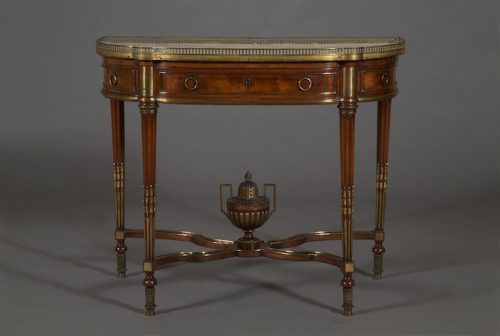
Research
Of mahogany and gilt bronze. The shaped white marble top with two bosses to the mounted with a pierced gilt brass gallery and edging above a conforming frieze with gilt brass edging below, the frieze set to the front with a single drawer with gilt edged panelling set with two gilt ring handles, flanked by two curving dummy drawers with single gilt ring handle, the drawers divided by reeded panels of gilt bronze, each reeded panel above a circular tapering leg with gilt bead moulding and banding to the neck, fluted and set with chandelle mounts, the legs joined by a shaped X-stretcher with gilt edging, the centre supporting an urn surmounted by a gilt pine cone finial above a top with gilt stiff leaf decoration, the top above a fluted frieze, the urn with gilt reeding set to either side with a geometric handle, raised on a shaped socle with gilt cabaling to the base, the whole raised on four feet continuing from the legs, each circular with gilt stiff-leaf and berry decoration above a moulded gilt foot. Stamped C.TOPINO to the reverse.
Provenance:
Acquired from an aristocratic family, Dorset, England.
Charles Topino (1742-1803) was elected maître-ébéniste in 1773 before being made deputé of his guild in 1782, a tribute to the esteem in which he was held by his contemporaries.
Topino specialised highly prestigious elegant neo-classical furniture of superb quality for members of the aristocracy, such as the marquis de Gravelle and the duc de Penthièvre. Topino’s furniture was often enriched with trompe l’oeil marquetry, however the present table belongs to a highly unusual group of just six known pieces he produced using richly figured mahogany mounted with gilt bronze.
The extremely rare pieces in Topino’s unadorned restrained style comprise a commode bearing the inventory label of Louis-Jean Marie de Bourbon, duc de Penthièvre, now in the apartments of Madame du Barry in Versailles, and five demi-lune side tables made around 1785. The stamp on the present piece, in which the C appears as if a G indicates the table was made after 1780.
Among the tables are two pieces closely related to the present console. A table sold in Orleans in 1980 of very similar design and proportions was stamped by Topino and featured an identical vase (albeit with missing handles). A further table sold in Zurich in 1981 (figure 1) had an identical shaped stretcher and a very similar vase and was closely comparable to the present piece with only a few small differences for instance to the feet and the marble top.
This distinctive stretcher centred by an urn also appears on a white painted table that belonged to the Mobilier de la Couronne, the design of which was recorded by Rodolfe Pfnor (figure 2). The tradition of an urn mounted on the stretcher of a table can be traced back the work of the ébéniste A.C. Boulle at the turn of the eighteenth century. However, such stretchers centred by an urn were more usually to be found in the work of a skilful carver or menuisier such as George Jacob, rather than the verneered furniture of the ébéniste
A carved table bearing the Jacob stamp in Paris in 1921 (figure 3) demonstrates the use of a comparable arrangement of stretcher and vase by this celebrated menusisier. The particularly fluid nature of the stretcher on the present table and the sculptural form of the vase that centres it demonstrate the extremely sophisticated craftsmanship achieved by Topino.
By the 1760s classical urns from models by ornemanistes such as La Londe appeared in the inlaid designs on furniture and tapestries as well as in porcelain. Inlaid vases on pieces by BVRB are thought to have been derived from Sevres designs, while a marquetry secretaire by Topino sold in Paris in 1930 depicted a vase in the design to the front panel which is closely comparable to those featured on tapestries designed by Jacques for the Gobelins manufactory.
The design of the urn and the shaped stretcher of the present piece is suggestive of the influence of the marchand mercier Dominique Daguerre. Daguerre supplied objects de luxe by a number of makers to the French court and after the revolution to the English nobility. In the 1780s he opened a shop in London on Picadilly, to supply George Prince of Wales (later George IV) and his circle.
Although there is no evidence of a collaboration between Daguerre and Topino, the shaped stretchers are reminiscent of the furniture of Adam Weisweiller sold by Daguerre. Weisweiller’s designs are more geometric than the stretcher on the present table, nevertheless the similarities provide a possible link between Topino and Daguerre with regard to this piece.
Topino was born into a family in which his father, Henry-Nicolas, and his brother, Jean-Baptiste Topino-Lebrun, were also ébénistes. Topino established himself in Paris in premises on the Rue du Fauborg-Saint-Antoine. The high calibre of Topino’s design and cabinet making was further enhanced through his collaboration with some of the finest craftsmen in Paris. For example Topino’s beautifully worked bronze dore was cast by Viret, chased by Chamboin and Dubisson and gilded by Becard, Gerard and Vallet.
Yannick Bapt
Paris, February 2003
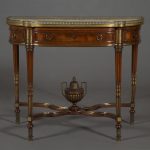
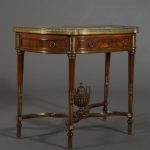
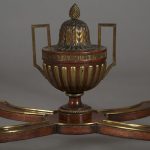
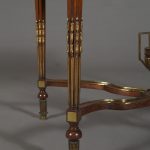
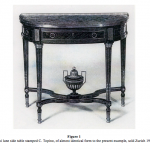

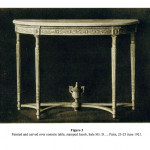
Comments are closed.